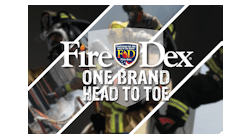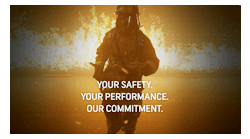Firehouse Magazine invited a cross-section of personal protective equipment (PPE) manufacturers to join our latest roundtable discussion centering on firefighter safety issues. Topics include safety-related improvements, color choices and protection from heat. We thank the companies participating in this roundtable and invite other manufacturers to join in future discussions.
CHIEFTAIN - TOM CLEMENTS
National Sales Manager
Chieftain Safety Mfg.
DUPONT - RICH YOUNG, Ph.D.
Senior Research Chemist
E.I. du Pont de Nemours & Co. Inc.
DuPont has introduced a new concept in thermal liner technology, DuPont Nomex On Demand. Available beginning this month, Nomex On Demand is a smart material designed to react at high temperatures, specifically 250 degrees, for increased thermal insulation. As the internal temperature of the garment increases, the new material will actually become thicker and improve the insulation performance of the garment. Yet, in routine conditions, Nomex On Demand remains thin, breathable and flexible. Lab studies look extremely promising and we are in the process of doing field trials to validate the improvements in protection.
FIREHOUSE: Are any colors of PPE being requested more than others? Does color matter in regard to the protection the gear will afford the wearer? YOUNG: Historically, the Northern cities chose black, and those in the South preferred lighter shades. More departments are looking for justification to switch to darker shades, which do not show soiling as easily. In most cases, the color of the outer shell does not significantly impact the thermal protection of the garment; most of a garment's thermal protection and heat stress relief is controlled by the inner components. In addition, most of the outer shell colors are transparent to radiant heat transmitted in a smoke-filled room, so the rate of heating is independent of color. The darker colors will also increase the contrast and visible impact of reflective trim. FIREHOUSE: At what temperature and for how long does the PPE provide protection before the wearer could become injured during severe structural firefighting conditions? YOUNG: Most burn injuries occur with minimal damage to the gear. All of the components in firefighter PPE are tested to 500 degrees Fahrenheit for five minutes to demonstrate stability. Unfortunately, the firefighter cannot be exposed to those temperatures without sustaining severe burn injuries. The PPE protects the wearer by using air layers between and within each component to reduce the transfer of heat energy. Injury occurs when the layers against the skin (face cloth, hoods, wristlets or stationwear) heat the skin faster than it can naturally cool itself. The rate that these materials heat up will depend on the external heat flux (rate of heat flow) and the efficiency of the insulation, moisture and compression will reduce the effectiveness of any insulation layer. The standard measure of insulation in a turnout composite is the TPP value; it exposes the fabrics to a temperature greater than 1,800 degrees Fahrenheit with a heat flux of 2.0 cal/sq cm-sec. All NFPA 1971-compliant turnout gear must provide a minimum TPP of 35 cal/sq cm. This would predict a burn injury after 17.5 seconds of exposure, but burn injuries can occur much faster because of stored energy, heat momentum or moisture in the materials.
FIRE-DEX - STEVE BONAMER
National Sales and Marketing
Manager, Fire-Dex
GLOBE - ROB FREESE
Senior Vice President Marketing
Globe Manufacturing Co., LLC
There is clothing we anticipate that will be commercially available in the coming year which will meet the stringent requirements of NFPA 1971 structural clothing combined with the CBRN option. We have been developing this technology with Homeland Security, DuPont and North Carolina State, implemented by the Technical Support Working Group, over several years for design and testing in live chemical and simulant environments.
We are a company who makes constant improvement with implementation a part of our culture. As the industry has come to adopt the requirements of NFPA 1851, which speaks to selection, care, and maintenance of firefighters' clothing, we have established Globe CARES (Cleaning And Repair Evaluation Services). This entity within our family of brands serves to provide education on the cleaning and repair of clothing so it can be ready to perform when the firefighter needs it, contributing better wellness by keeping the clothing more free of unburned particulate and chemical effluent released by combustion.
What we learn helps the clothing supply chain and the standards process as well. W.L. Gore has developed a moisture barrier that is more durable with respect to abrasion. Globe provides an Internet program without charge called www.ppetracker.com for the purposes of assisting with the documentation required for a department to become compliant with the 1851 standard.
FIREHOUSE: Are any colors of PPE being requested more than others? Does color matter in regard to the protection the gear will afford the wearer? FREESE: Color has been a matter of preference for the authority having jurisdiction (AHJ) often as an association of a particular function. For example, we as humans can segregate by color much faster than by reading, so a chief wears white and departments wear differing colors as a matter of easy operational differentiation. Many departments have traded in yellow, originally purchased for visibility in favor of gear that uses more protective fibers, but which don't lend themselves to being dyed because of their high-tech chemical make-up. As for protection from heat and flame, there have been studies in the past that indicated in a layered system such as turnout gear color has little effect on the wearers' comfort or performance.Firefighters being killed or injured in roadway incidents has caused folks to adopt ANSI requirements for roadway operations. These standards require fluorescence in their background color, something which is not yet attainable with today's technical inherent flame resistant fibers and dye technology, combined with retroreflective performance. To be compliant, departments have to sacrifice flame resistance by donning a traffic vest, a situation we hope to be able to mitigate with, first, a better understanding of what the approaching motorist deems visible and adopting technology that corresponds with those findings.
FIREHOUSE: At what temperature and for how long does the PPE provide protection before the wearer could become injured during severe structural firefighting conditions? FREESE: This is a more complex issue than many often give credit. In a catastrophic event, such as a flashover, the gear is designed to give protection for a minimum of 17.5 seconds before the wearer sustains a second-degree burn (TPP 35). That being said, there are many circumstances firefighters encounter that are less severe, yet they sustain a burn injury. Getting burned is a function of time and temperature. Think of moving your finger through the flame of a candle. You can do it! Leave it there and you are going to get burned. Tissue damage from heat is a function of time and temperature. The clothing we wear includes fibers primarily of Nomex, Kevlar, PBI and PBO. These fibers will endure heat from 800F to 1,200F before their properties change and break down; human skin begins around 130F. Under lower heat condition, this tells us that a temperature exposure above 130F long enough will yield human skin damage, perhaps with no detrimental effect on the gear whatsoever! Training and awareness are critical to staying safe.
INNOTEX - LOUIS CARPENTIER
President
Innotex Inc.
It is known that skin will suffer a second-degree burn if it receives an energy amount equal to 1 calorie per surface area. The NFPA committee has decided that TPP testing should be done at 2 cal/s, the equivalent of a flashover situation. So theoretically, a gear with a TPP of 40 would allow a firefighter 20 seconds to escape a critical condition such as a rollover before sustaining a second-degree burn.
Of course, this result can be influenced greatly by the conditions of the garment, its wetness, age, conditions as well as how it was maintained, etc.
LAKELAND - ADAM R. PARKER/>
National Sales Manager
Woven Products/Fyrepel/Reflective Apparel Div. Lakeland Industries Inc.
The addition of the DRD, drag rescue device, that is used for a person that is down in a rescue situation. The thermal liner in the shoulder area of the garments must be double layered and the THLs were adjusted in order to maximize breathability and comfort.
FIREHOUSE: Are any colors of PPE being requested more than others? Does color matter in regard to the protection the gear will afford the wearer? PARKER: Based upon our history, khaki and black are our two most requested colors. Color really doesn't matter in reference to the protection the gear will afford the wearer. The protection is based upon fabric and fabric combinations in order to reach the optimal TPP and THL performances. FIREHOUSE: At what temperature and for how long does the PPE provide protection before the wearer could become injured during severe structural firefighting conditions? PARKER: Since this is not usually a controlled situation, and the user has many different options regarding outer shell, thermal barrier and moisture barrier combinations, the temperature will vary based upon the many combinations the user has to choose from. NFPA 1971, 2007, offers a good outline on the minimum standards all gear needs to meet based upon the TPP and THL.
PBI - KIMBERLY M. HENRY
Director of Marketing & Sales - NA Performance Fabrics
PBI Performance Products Inc.
With the introduction of technical rescue (USAR) PPE, again PBI Performance Products has developed and introduced PBI Triguard, a lightweight, 5.3-ounce, comfortable, but durable and flash fire resistant (four-second exposure) fabric for this highly demanding market.
FIREHOUSE: Are any colors of PPE being requested more than others? Does color matter in regard to the protection the gear will afford the wearer? HENRY: Gold seems to be the standard for turnout gear outer shells. Before the introduction of PBI Gold outer shell in the late '80s, the standard outer shell color was yellow. But since PBI Gold represented premium protection and performance in the fire service market, new outer shells introduced in the '90s were "gold-like" in color. The natural or gold color of PBI outer shells continues to represent the largest portion of sales in the market. Another color which seems to be making a comeback in the market is black. This color represents tradition in the fire service and in wear tests has proven to be as durable and protective as gold without adding stress to the wearer due to heat. To date, I have not seen any studies in which the core temperature of the wearer increased due to the color of the outer shell used in a set of turnout gear. FIREHOUSE: At what temperature and for how long does the PPE provide protection before the wearer could become injured during severe structural firefighting conditions? HENRY: The NFPA 1971 standard, 2007 edition, requires a minimum thermal protective performance (TPP) average of 35 cal/cm2-sec. The TPP test measures the thermal insulation of protective ensembles used for structural firefighting. This minimum averaged value represents the amount of time - 17.5 seconds - in which a second-degree burn would occur when exposed to two calories of heat and flame (approximately 1,800-2,000 degrees Fahrenheit/flashover-type conditions) in a protective garment element composite consisting of an outer shell, moisture barrier and thermal barrier. All NFPA 1971 third-party-certified garments meet this minimum requirement. As the world's only producer of PBI fiber, PBI Performance Products develops outer shell technologies that provide break-open protection under extreme firefighting conditions. Since the degradation temperature of PBI outer shells are approximately 1,300F, they provide break-open protection of the moisture and thermal barriers, which begin to degrade at lower temperatures comparable to the levels of aramids during severe firefighting conditions.
SAFETY COMPONENTS - JOEY UNDERWOOD
Senior Vice President
Safety Components International Inc.
Armor 7.0 combines a 50% content of military-grade ballistic Kevlar with a spun-yarn blend of Nomex and Kevlar in a lightweight fabric. By using 50% military-grade ballistic Kevlar, we are delivering fabric tensile and tear strength never before seen in outer shells. This all translates into better protection from rips and tears and improved fabric integrity and strength after exposure to flame. We also developed Armor with our ComfortBlend weave to provide better freedom of movement for lower work stress.
Our ShadowBox thermal liners optimize filament Nomex to deliver enhanced lubricity and moisture management for firefighters. We believe thermal liners are generally an unappreciated part of the firefighter ensemble, but they actually play as great a role in firefighter safety as the outer shell. Heat stress affects firefighters daily so these improvements to freedom of movement and moisture management are a critical enhancement for firefighter safety. We think ShadowBox is an excellent addition to our Glide and Chambray thermal liner systems.
FIREHOUSE: Are any colors of PPE being requested more than others? Does color matter in regard to the protection the gear will afford the wearer? UNDERWOOD: Gold. We are selling more gold outer shells than any other color and the trend to gold continues to escalate. Some cities prefer black and will always prefer black, but we don't see any great change in black demand. Our other colors such as yellow and bronze are running at historical rates. FIREHOUSE: At what temperature and for how long does the PPE provide protection before the wearer could become injured during severe structural firefighting conditions? UNDERWOOD: Outer shells with PBI fiber, such as our PBI Matrix, provide better thermal protection in flashovers than shells of other fibers. Our new Armor 7.0 also provides better protection than traditional fiber-blended outer shells. Our patented Teflon F-PPE that we add to all our outer shell fabrics, help keep water out of the system to greatly reduce the propensity for steam burns.Again, however, I must stress the importance the thermal liner plays in this equation. The thermal liner/moisture barrier combination will drive TPP and THL performance. It is the system, and how the system is engineered, that provides protection from heat. Firefighters need to really understand the performance of each layer in their PPE.
SPERIAN - ANTHONY Di GIOVANNI
Strategic Marketing Director
Sperian Protective Apparel
TENCATE SOUTHERN MILLS - ELLIAD GRANGER
Marketing Manager
TenCate SouthernMills Inc.
W.L. GORE - HOLLY BLAKE
Product Specialist
W.L. Gore & Associates Inc.
With NFPA 1851's increased emphasis on turnout gear maintenance, CROSSTECH 3-Layer Moisture Barrier offers the best possible combination of durability, THL and TPP available in today's market. CROSSTECH 3-Layer Moisture Barrier provides the breathability and comfort that firefighters need when encountering the high temperatures at emergency scenes; at the same time, its rugged three-layer construction adds an increased level of durability against abrasion and flexing, which means added safety and protection against blood, body fluids, NFPA common chemicals and water.
PPE garments made with Gore CHEMPAK Selectively Permeable Fabric provide a high level of THL while protecting the firefighter against specified toxic industrial chemicals (TICs) and chemical warfare agents (CWAs). NFPA 1971 states that PPE ensembles meeting the CBRN option of the standard are intended to provide a "minimum level of protection for firefighting personnel from specified CBRN agents." Gore CHEMPAK Selectively Permeable Moisture Barrier Fabric is the only barrier available in the market today that is component recognized to the NFPA 1971 CBRN option and has successfully met the minimum barrier performance requirements and extensive preconditioning challenges established by the standard. Comprehensive ensemble field testing is expected to begin shortly with departments throughout North America to firmly establish fitness for use. Gore is confident that PPE ensembles using this product will be certified to the NFPA 1971 CBRN option in the near future.
FIREHOUSE: At what temperature and for how long does the PPE provide protection before the wearer could become injured during severe structural firefighting conditions? BLAKE: The outer shell is PPE's primary defense against direct flame and heat, while the thermal liner provides thermal insulation. These two components, combined with the moisture barrier, determine the thermal protective performance (TPP) and total heat loss (THL) of a specific set of gear. While the moisture barrier is not the primary protection against flame or heat, it does have the greatest impact on breathability, which studies have shown to be an effective way to reduce firefighter heat stress. When taken together, THL and TPP are an excellent measurement of performance provided by a particular combination of outer shell, thermal liner and moisture barrier. Additionally, the PPE inspection process should not be overlooked. Although the moisture barrier is not the primary protection against flames, it can suffer thermal damage if the outer shell or thermal barrier has been compromised.







